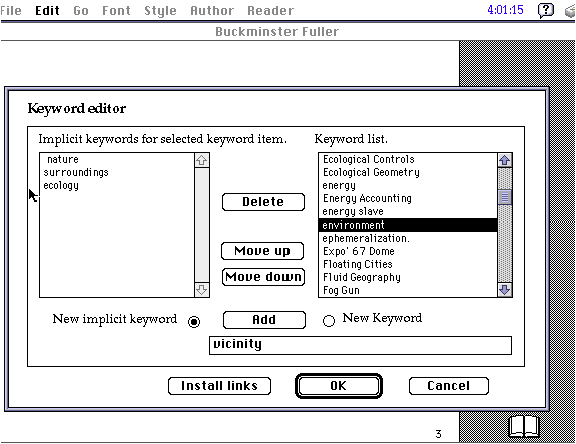 John Wood,
John Wood,Programme Director, MA in Design Futures, Goldsmiths University of London, London,UK. Dynamics of the IDEAbase 'situated knowledge system'
John Wood
Programme director, MA in Design Futures Goldsmiths University of London New Cross SE14 6NW England
Abstract
This paper examines the metaphor of scholastic 'rigour' in terms of digital communications technology, and asks whether it affords 'helpful' modes of research in the interactive '4-D' design studio. In doing so, it also challenges common[3] assumptions about the pathways between 'theory' and 'practice' in the age of the 'virtual library'. The paper refers to a historical conflict between methodologies of 'research' and 'studio practice', that has come into sharper focus since the UK government's pressure on the 'new' universities to attain excellence in 'research'. It critically examines the origins of scholastic research methods in the context of design practice, and refers to the author's IDEAbase system to show how scholarship could be made more situated and convivial. This project is intended to inform studio practice in a more immediate 'result-oriented' way, rather than promoting rigorous critical commentary 'for its own sake'.
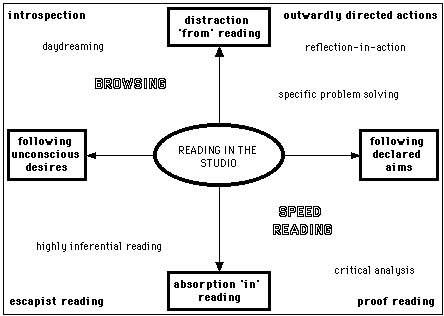
Click to enlarge then BACK to return.
It is increasingly clear that many complex world problems require a deeper, more concerted and better informed response from people of influence. In this respect, designers have a key role in improving collective attitudes to ecology and the 'common good'. Nevertheless some claim that designers "don't read much" (Frayling, 1994), because they are steeped in the visual culture of busy professional practice and do not see a commercial need for rigorous textual research.
Bob Stein, chairman of Voyager Interactive Books Inc. conducted an experiment in which he asked designers depict the Gulf War on paper without using words. All were surprised to find themselves unable to locate their ideas within even the simplest social and political terms of reference.
Conflict of reading with design practice
If, as seems likely, designers must learn to read and write in a more disciplined way, then this may pose a problem. It requires just as much time to become a successful designer as it does to be a 'rigorous' researcher. For the well-intentioned designer working to a deadline, beset with improvised suppositions, and over-awed by the weight of 'essential' reading matter, impatience can soon turn into a cynical, 'hit-and-run' assault on texts either fashionable or obscure. Practical work in the design studio seems to call for 'embodied' skills and 'situated' judgements rather than detached, intellectual 'decisions'. Donald Schön and others blame the historical split between the mediaeval monasteries and craft-guilds for the 'theory-practice' conflict that some students experience on design courses. Where the university research tradition stems from the monastic methods of book-based learning, studio practices are more identifiable with commercially oriented, 'hands-on' methods that fostered the schools of art, craft, and design. For the purposes of the artist and the designer, these separate traditions have left us with two incommensurate ideas of 'knowledge':
In more than a decade since Schön wrote about the issue, the art and design schools have done some good work on both sides of the gap, and most good students of practice become comfortably fluent in the writing of essays and dissertations. Having said this, it is still unclear how, when, and where 'truth-oriented' types of knowledge can properly inform 'task-oriented' methods that produce practical results.
Despite this confusion, few educationists seriously challenge the accepted scholastic models of essay writing. Even in the current debate surrounding electronic publishing in academic research there is little questioning of the efficacy of 'rigorous' writing, and many design students within the new universities are still encouraged to follow the conventions of 'rigour' in their written work. Why is this so, where does our idea of 'rigour' come from, and is it the best methodology for designers in the age of the 4D studio?
The idea of rigour in a research context refers to the severity, strictness, and harshness of its methods of 'objective' study and analysis. We should not forget that 'rigour' has many morbid connotations, including that of a sudden chill, or shivering before fever. When we refer to a library as a 'corpus of knowledge' we are also reminded of the rigidity of the body caused by shock, poisoning, etc., or of the ('rigor mortis') stiffening of the body after death.
I would argue that the general metaphor of 'rigour' is anachronistic and out of place for artists and designers in the studio. The quantum physicist, David Bohm[4], has said that "from the fact that in Einstein's point of view no signal faster than light is possible, it follows that the concept of a rigid body breaks down." This new principle of 4D dynamics challenges the metaphor of rigour in thinking, reading, and writing.
Roots of rigour - a solid universe
The roots of rigour can be seen as part of Gutenburg's 'knowledge revolution' in which the situated fluency of handwriting was 'hardened' by its transformation into mechanical printing. This is also reminiscent of the much earlier 'hardening' of knowledge through the pre-historic transition from speech into writing. The anthropologist Jack Goody reminds us that text "tends to arrange terms in (linear) rows and (hierarchical) columns in such a way that each item is allocated a single position, where it stands in a definite, permanent, and unambiguous relationship to the others".
Parmenides was perhaps the most influential[5] of the early Greek philosophers to be associated with the strange idea of 'rigour', as he is credited[6] with the idea of a solid and 'immobile' universe. More importantly he also used this rigid cosmogony to describe discourse, alluding to the "unmoving heart of a well-rounded truth"[7]. In this sense we could say that the Parmenidean universe is not only spatially, but temporally solid, and would therefore be resistant to all motivation, inquiry and innovation. Plato was greatly influenced by Parmenides and managed to create an enduring mindset[8] that prioritised 'matter' above 'movement', and 'form' above 'matter'. Clearly, these ideas seem very unsupportive to creative studio practices in today's digital culture!
Descartes is often cited as the prototypical 17th century thinker who believed that serious questions should always be framed as clear, stringent, and indubitable hypotheses bound together by 'geometrical' chains of reasoning into a solid structure of irrefutable truth. His waspishness was famously militaristic in its readiness to move mountains in the name of truth.[9] If the 'rock' of the Enlightenment was a faith in, and an emphasis on, 'reason', it should be remembered that this was a direct legacy of Greek thought that had survived, in a somewhat intensified and superstitious form, through the middle ages. What grew out of a turbulent, bewildering, and hostile mediaeval world was the stabilising, and comforting maxim of "a place for everything, and everything in its place". Certainly, it would seem that the mediaeval monastic tradition was founded upon a retreat from insecurity, giving rise to "communities that were stable, orderly, and tranquil"[10]. From this 'unworldly' atmosphere, a remarkable number of texts, both secular and religious, were produced. This fact provides some explanation for the association of books with a lifetime's devotion to the painstaking processes of reading and copying from one manuscript to another.
Panofsky refers to the mediaeval 'scholastic mind'[11], and describes the closed and introspective mode of writing that it fostered. He talks of "clarification for clarification's sake", observing that this required a "...maximum of explicitness[12] and a "gratuitous clarification of thought through language."[13] Gelrich[14] argues that the rigid mediaeval writing style eventually became the object of its own scrutiny[15], and in doing so, had to itemise - in totality - all its constituent parts or 'members', taking care to retain a structural coherence among those parts. The strong urge to explication was maintained by a number of devices familiar to the modern scholar such as 'comparisons'[16] and contrasts[17].
One reason why the myth of 'rigidity' survived so long in the middle ages is the perceived correspondence between the universe and the human form. Panofsky suggests that the awesome spectacle of the cathedral exemplified, on the one hand, an idealised and rigid universal order and, on the other, a writing method that demanded from its scholars and priests a matching regime of equally scrupulous rigour. He points out that scholastic writing demands "distinctiveness and deductive cogency" and finds, both in the spatial edifices of the mediaeval cathedral and in the structural rules of scholastic writing; an "arrangement according to a system of homologous parts...As a result of this homology we perceive what corresponds to the hierarchy of 'logical levels' in a well-organised Scholastic treatise." In both cases, a totalising order of fixed relationships is embodied within structures that signify sacred meanings on every level, from the broadest generalisation down to the smallest detail. Similarly, in mediaeval paper based documents, writings were copied and 'mistakes' made inadmissible, thus confirming the authority and 'solidity' of their content.
Rigour in the 4D design studio
All these structural tendencies of fixity and solidity are, to a lessening extent, preserved by the academic research traditions in the modern university. Yet we also know that text has been loosened up by being lifted off the page and piped into computers in a far more fluid and dynamic form. In this context we must ask ourselves whether rigorous research is still appropriate and, if so, how designers can attain it within a digital culture. The hope that 'smart' information technologies would be able to guide the designer into easier decision making has so far proved elusive. Some workers, for example, had hoped that user-friendly databases could eliminate the need for time spent in the library. However, recent studies show that ecological knowledge (Billet & Perkins, 1994)[18] and ethical knowledge (Clarke, 1994)[19] is too ill-defined and complex to be reduced into general 'rules for action'. In other words, the responsible designer of the future will still need to be a good reader!
Pragmatically speaking, the problem with 'objective' paradigms of research is that although printed text is linear, the act of reading can never be an 'action replay' of the act of writing. It also reminds us that all representation must be bound by finite limits that render them 'partial' and subjective. This mismatch embraces several unvoiced myths of rigour which I will attempt to make explicit. Firstly, to attain rigour is to have first read profoundly, extensively and comprehensively. This poses a number of crucial heuristic problems. In particular, the order in which ideas are apprehended affects the sense that is created in the mind of the reader.
Although today's digital computer (usefully) "reads" and "processes" text characters at a speed which far outstrips human performance, humans do not behave like linear processing mechanisms. This is because our cognitive capabilities are led by ideas, interests[20], and desires. In which order, for example, should we read the works of Shakespeare? Do we read them in the same order in which we believe that the author wrote the works? Should we know much, or little, about his life and reputation before we encounter his works? Do we read straight through without stopping to reflect upon context, or do we interrupt Shakespeare's reading flow to acquire more expert guidance 'en route'? None of these questions are inclusive, and if we choose one path we are unable to redress our steps and to take a 'fresh' alternative. Heraclitus summarised this problem in his famous aphorism: "On those who step into the same rivers, different and different waters flow"[21]
Heraclitus went further[22] in describing the conflict between a dynamic 4D event and how we represent it in a static form, saying that: "If a thing is true, it cannot be stated"[23]. This is a crucial idea that may inform questions surrounding reading in the design studio. Often, actual situations are too contingently complex to be theorised usefully at times of critical need. At such times, unpremeditated, situated actions may be the only recourse to meeting the unforeseen. Admiral Nelson once expressed this 'active truth' as a withdrawal from predictive, rule-based order when he said: "Something must be left to chance; nothing is sure in a sea fight beyond all others."
Similarly, Wittgenstein reminds us of the 'situatedness' of verbal language: 'Conversation flows on, the application and interpretation of words, and only in its course do words have their meaning'[24] For problem solving in 'real-life' situations, the idea of research 'rigour' often seems less than helpful. More specifically, for the busy professional designer who wishes to apportion some of her valuable time to the library, there is a inevitable trade-off between the mechanical processes of reading, and the search for an answer to a specific question, whether openly declared or implicit.
Plato said that books are like the painted figures that "seem to be alive, but do not answer a word to the questions they are asked." The computer is now able to help us re-design the discourse of 'dynamic truth'. We can, for example, differentiate between "temporal" and "atemporal" questions and illustrates a key distinction between the questions that could be asked of a '2D' and a '4-D' document. Only in a 4D document can we differentiate between "result-seeking" questions (why did you ask me that question?) and "cause-seeking" questions (Why did you conclude that?)[25].
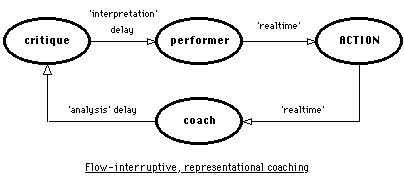
Click to enlarge then BACK to return.
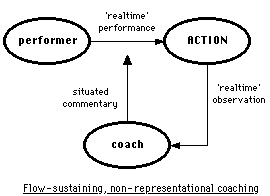
Click to enlarge then BACK to return.
In describing the particular methods of 'studio' practitioners, Donald Schön coined the term 'reflection-in-action'
The IDEAbase system
IDEAbase[28
[1] The term artist-designer was coined by Crampton-Smith and Tabor (1994). As Lawson (1990) notes "design" can refer to many disciplines, the distinction between artist-designer (i.e. film, theatre, graphic and industrial design) and engineering-design (i.e. computer programming and mechanical engineering) serves as a useful distinction. [2] For instance, the code which controls an Adobe Photoshop filter is not the same code which controls the menu that triggers it into action, nor the same code that displays the results. [3]1common to many active design practitioners and affirmed by the initial results of our research data. [4]Bohm, D., "Wholeness and the Implicate Order" Ark Paperbacks, London 1983 [5]There is some doubt as to the entire truth of this statement, when his work is analysed in its entirety, but certainly, Melissus is a stronger contender for this title. [6]Caution here is advocated by Barnes....who, despite acknowledging the short, but clear, texts that seem to state an unequivocally monistic position, nevertheless claims that Parmenides presents a more balanced position when explored in entirety. [7]He argued that the world is: "ungenerated and undestroyed....whole, of one kind and motionless": Jonathan Barnes "The Pre-Socratic Philosophers" vol. 1 Routledge and Kegan Paul, London 1979, from B8 [8]George Bataille describes this legacy sardonically: "To our way of thought, derived as it is from a tradition of monism, matter cannot be conceived as distinct from form, because matter has already been caught up in a 'systematic abstraction'. It has been constructed within a relationship between two verbal entities; 'abstract God (or, simply, Idea) and abstract matter, the prison keeper and the prison walls." (George Bataille, quoted by Rosalind Krauss in "The Retinal Unconscious", p. 150) [9]Descartes: from the 1st meditation: "I realised that it was necessary, once in the course of my life, to demolish everything completely and start again from the right foundations if I want to establish anything at all in the sciences that was stable and likely to last." [10]Eco, U., "Art and Beauty in the Middle Ages", Yale University Press, 1986, (1959) [11]Panofsky, I., "Gothic Architecture", pp. 35 [12]Latin word: 'manifestatio' [13]Panofsky, I., "Gothic Architecture", pp. 59-60 [14]Gelrich, J., "The Idea of The Book in the Middle Ages", p. 66 [15]Latin word: 'speculum' [16]Latin word: 'similitudines' [17]Latin word: 'distinctiones' [18]Billett, E., H., and Perkins, M., "The Importance of Judgemental Factors in Environmentally Sensitive Design", IDATER '94, International Conference on Design and Technology Educational Research and Curriculum Development, Dept. of Design and Technology, Loughborough University of Technology, August 1994 [19]Clarke, M., "Ethics or Design, or Ethics for Design?", unpublished paper, Goldsmiths University, 1994 [20]Dr. Johnson: "A man ought to read as inclination leads him; for what he reads as a task will do him little good." Boswell's "Life of Johnson", 9th July, 1763 [21] (43:B12=40M) [22]Like his pupil, Cratylus, who created an additional hyperbolic dimension by declaring "You cannot put your foot into the same river once" [23]Wittgenstein reframes this idea in his Tractatus Logico Philosophicus: "What can be shown, cannot be said." 4.1212 [24]Wittgenstein, 1980 [25]Hughes, S., "How and Why: How far will they take us, why should we need any more?" - Proceedings of a Workshop on Explanation. London, Alvey, 1986 [26]Schön, D., "The Design Studio" 1985 [27]Guignon, C., B., (ed.) "The Cambridge Companion to Heidegger", Cambridge University Press, 1993, p.130 [28]Wood, J., & Clarke, J., "A Convivial Authoring Environment for Researchers in Art & Design", Conference Paper, Prolog in Education Group '93, Heriot Watt University, Edinburgh; 1993 July Wood, J., & Taylor, P., "Mapping the Mapper", Special Edition of the (refereed) Electronic journal of Virtual Culture dedicated to "Mapping", ed. Donald Day, Syracuse University, N.Y., USA, May 1994 Wood, J., : "Chaos and the Virtual Library - strange attractors in the design studio", paper given at IDATER '94 conference (International Design and Technology Education Research) at Loughborough University, Leicestershire, UK
The Author Can `Edit' Relationships Between Visible and Implicate Keywords
Once the author has nominated primary (visible) keywords, the author is then given the opportunity to create (invisiuble) 'implicite keywords' if required, adding an implicit keyword string to each keyword in the text. this task entails a familiar literary habit ie .word-association, and it is in the main (unconscious) basis upon which authors create their own web of contextual issues.
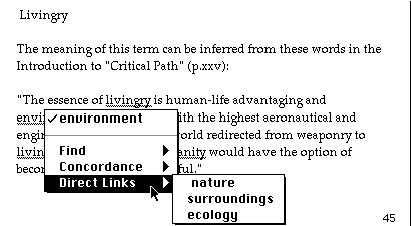
Click to enlarge then BACK to return.
The Reader is Able to Click on Any Part of the Text to Initiate a Search
Readers who are looking for specific concepts are automatically directed along paths of associateds and offered excerpts from which to choose a suitable text. this dynamic web then becomes the intelligent mechanism by which readers can extract coherent and relevant knowledge form a series of documents thatwould otherwise have remained independent.
For more SYNDICATE SPEAKERS For other SYNDICATES |
